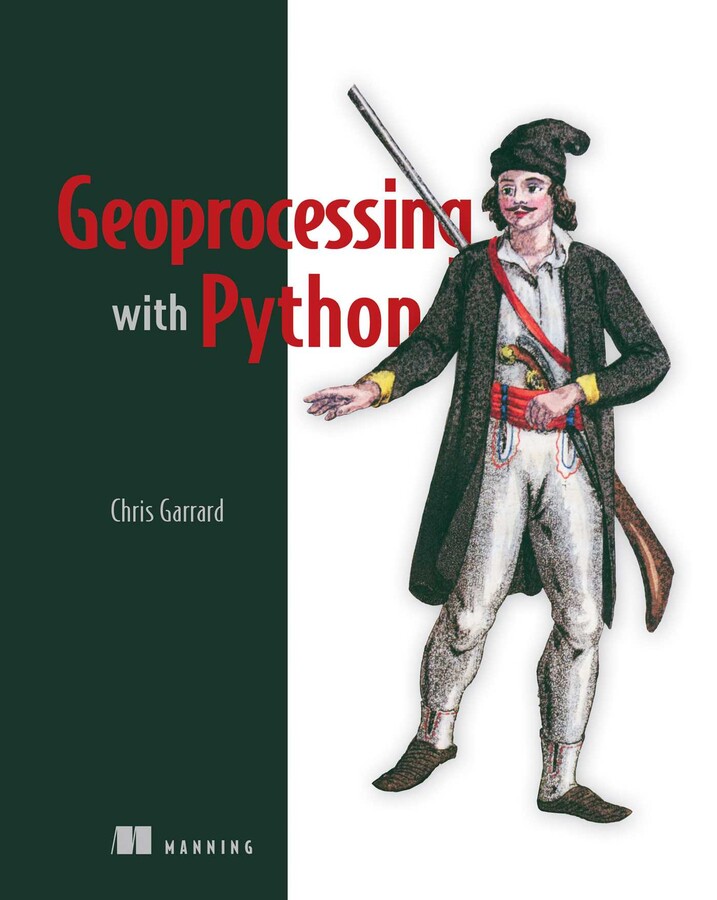Plus, receive recommendations and exclusive offers on all of your favorite books and authors from Simon & Schuster.
Geoprocessing with Python
Published by Manning
Distributed by Simon & Schuster
Table of Contents
About The Book
Summary
Geoprocessing with Python teaches you how to use the Python programming language, along with free and open source tools, to read, write, and process geospatial data.
Purchase of the print book includes a free eBook in PDF, Kindle, and ePub formats from Manning Publications.
About the Technology
This book is about the science of reading, analyzing, and presenting geospatial data programmatically, using Python. Thanks to dozens of open source Python libraries and tools, you can take on professional geoprocessing tasks without investing in expensive proprietary packages like ArcGIS and MapInfo. The book shows you how.
About the Book
Geoprocessing with Python teaches you how to access available datasets to make maps or perform your own analyses using free tools like the GDAL, NumPy, and matplotlib Python modules. Through lots of hands-on examples, you’ll master core practices like handling multiple vector file formats, editing geometries, applying spatial and attribute filters, working with projections, and performing basic analyses on vector data. The book also covers how to manipulate, resample, and analyze raster data, such as aerial photographs and digital elevation models.
What's Inside
About the Reader
To read this book all you need is a basic knowledge of Python or a similar programming language.
About the Author
Chris Garrard works as a developer for Utah State University and teaches a graduate course on Python programming for GIS.
Table of Contents
Geoprocessing with Python teaches you how to use the Python programming language, along with free and open source tools, to read, write, and process geospatial data.
Purchase of the print book includes a free eBook in PDF, Kindle, and ePub formats from Manning Publications.
About the Technology
This book is about the science of reading, analyzing, and presenting geospatial data programmatically, using Python. Thanks to dozens of open source Python libraries and tools, you can take on professional geoprocessing tasks without investing in expensive proprietary packages like ArcGIS and MapInfo. The book shows you how.
About the Book
Geoprocessing with Python teaches you how to access available datasets to make maps or perform your own analyses using free tools like the GDAL, NumPy, and matplotlib Python modules. Through lots of hands-on examples, you’ll master core practices like handling multiple vector file formats, editing geometries, applying spatial and attribute filters, working with projections, and performing basic analyses on vector data. The book also covers how to manipulate, resample, and analyze raster data, such as aerial photographs and digital elevation models.
What's Inside
- Geoprocessing from the ground up
- Read, write, process, and analyze raster data
- Visualize data with matplotlib
- Write custom geoprocessing tools
- Three additional appendixes available online
About the Reader
To read this book all you need is a basic knowledge of Python or a similar programming language.
About the Author
Chris Garrard works as a developer for Utah State University and teaches a graduate course on Python programming for GIS.
Table of Contents
- Introduction
- Python basics
- Reading and writing vector data
- Working with different vector file formats
- Filtering data with OGR
- Manipulating geometries with OGR
- Vector analysis with OGR
- Using spatial reference systems
- Reading and writing raster data
- Working with raster data
- Map algebra with NumPy and SciPy
- Map classification
- Visualizing data
Appendixes
- A - Installation
- B - References
- C - OGR - online only
- D - OSR - online only
- E - GDAL - online only
Product Details
- Publisher: Manning (May 5, 2016)
- Length: 360 pages
- ISBN13: 9781638353140
Browse Related Books
Resources and Downloads
High Resolution Images
- Book Cover Image (jpg): Geoprocessing with Python eBook 9781638353140











